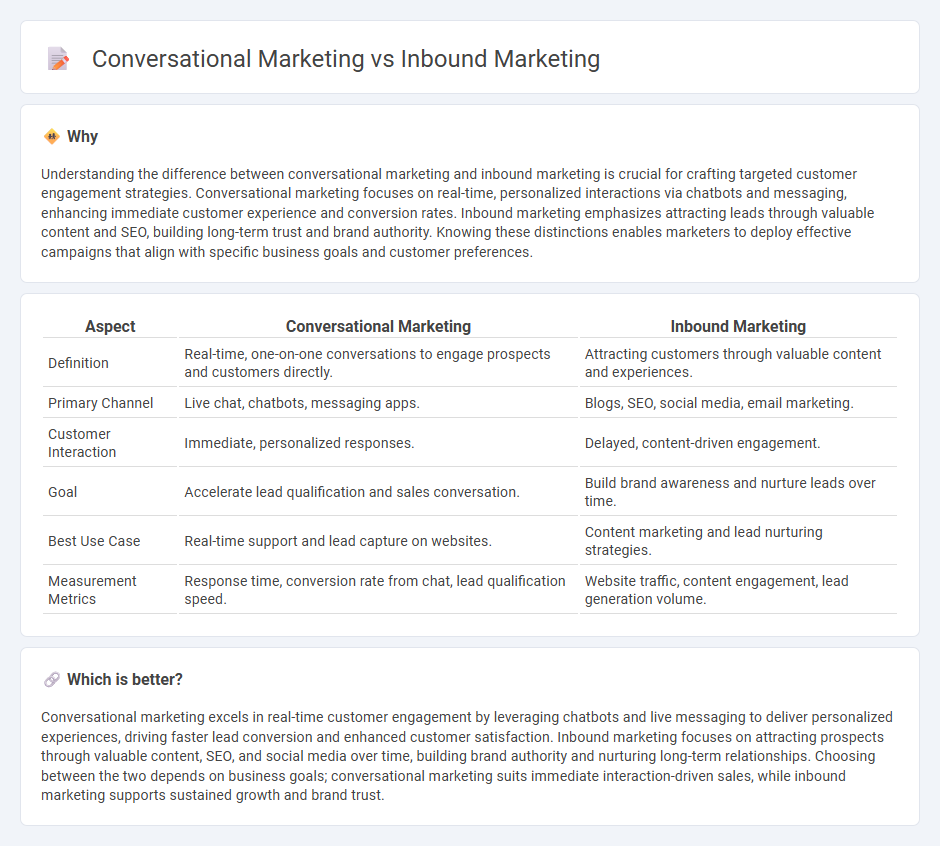
Conversational marketing leverages real-time, personalized interactions through chatbots and messaging platforms to engage customers instantly, enhancing user experience and boosting conversion rates. Inbound marketing focuses on attracting potential customers by creating valuable content and optimizing SEO to draw organic traffic over time. Explore the key differences and benefits of these strategies to elevate your marketing approach.
Why it is important
Understanding the difference between conversational marketing and inbound marketing is crucial for crafting targeted customer engagement strategies. Conversational marketing focuses on real-time, personalized interactions via chatbots and messaging, enhancing immediate customer experience and conversion rates. Inbound marketing emphasizes attracting leads through valuable content and SEO, building long-term trust and brand authority. Knowing these distinctions enables marketers to deploy effective campaigns that align with specific business goals and customer preferences.
Comparison Table
| Aspect | Conversational Marketing | Inbound Marketing |
|---|---|---|
| Definition | Real-time, one-on-one conversations to engage prospects and customers directly. | Attracting customers through valuable content and experiences. |
| Primary Channel | Live chat, chatbots, messaging apps. | Blogs, SEO, social media, email marketing. |
| Customer Interaction | Immediate, personalized responses. | Delayed, content-driven engagement. |
| Goal | Accelerate lead qualification and sales conversation. | Build brand awareness and nurture leads over time. |
| Best Use Case | Real-time support and lead capture on websites. | Content marketing and lead nurturing strategies. |
| Measurement Metrics | Response time, conversion rate from chat, lead qualification speed. | Website traffic, content engagement, lead generation volume. |
Which is better?
Conversational marketing excels in real-time customer engagement by leveraging chatbots and live messaging to deliver personalized experiences, driving faster lead conversion and enhanced customer satisfaction. Inbound marketing focuses on attracting prospects through valuable content, SEO, and social media over time, building brand authority and nurturing long-term relationships. Choosing between the two depends on business goals; conversational marketing suits immediate interaction-driven sales, while inbound marketing supports sustained growth and brand trust.
Connection
Conversational marketing and inbound marketing are interconnected through their focus on personalized customer engagement and relationship building. Conversational marketing leverages real-time interactions, such as chatbots and messaging apps, to guide prospects through the sales funnel initiated by inbound strategies like content creation and SEO. This integration enhances lead nurturing, increases conversion rates, and aligns marketing efforts with customer preferences and behaviors.
Key Terms
Content Creation (Inbound Marketing)
Inbound marketing centers on creating valuable, relevant content such as blog posts, ebooks, and videos that attract and engage target audiences, driving organic traffic and generating leads over time. Content creation in inbound marketing emphasizes SEO strategies, keyword optimization, and educational materials that build trust and authority within a niche. Explore how mastering content creation can amplify your inbound marketing success and deepen customer relationships.
Lead Nurturing (Inbound Marketing)
Inbound marketing excels in lead nurturing by delivering personalized content that guides prospects through the buyer's journey, leveraging SEO, email campaigns, and valuable resources to build trust and engagement. Conversational marketing enhances this process through real-time interactions via chatbots and messaging platforms, enabling immediate responses and tailored experiences that accelerate decision-making. Discover how combining inbound strategies with conversational tools can boost lead conversion rates and improve customer relationships.
Chatbots (Conversational Marketing)
Inbound marketing attracts potential customers through content creation, SEO, and social media, while conversational marketing leverages chatbots to engage visitors in real-time, providing personalized interactions and immediate responses. Chatbots enhance customer experience by qualifying leads, answering questions, and guiding users through the sales funnel efficiently. Discover how integrating chatbots into your marketing strategy can boost conversions and deepen customer relationships.
Source and External Links
What is inbound marketing? - Optimizely - Inbound marketing is a methodology focused on organically attracting target customers by providing valuable content through channels like SEO, content marketing, and social media, aimed at increasing lead generation, engagement, and conversions by meeting customer needs at the right time.
What Is Inbound Marketing? - HubSpot - Inbound marketing builds loyal customers by aligning marketing efforts with audience needs, creating valuable content that pulls customers in, and fostering lasting relationships through strategies such as social media, email marketing, and blogging to support growth via a self-sustaining flywheel effect.
What is inbound marketing? - Adobe Experience Cloud - Inbound marketing captures and nurtures qualified leads by putting useful information where the target audience can find it, leveraging content creation, SEO, and social media to build trust and generate leads by addressing customer inquiries during their discovery phase.
 dowidth.com
dowidth.com